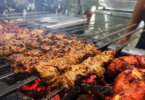TIGRAY (Agencies): In nearly two months, Kiflom Tekleweyni has eaten very little. The 23-year-old, who was born with an undiagnosed mental illness, and his mother fled their hometown of Dansha in Ethiopia’s war-hit Tigray region in mid-March. “We have been expecting to receive food aid after we got here,” Kiflom’s mother, Mulu Yirdaw, told Al Jazeera from Shire, a town further east. “But it has been almost two months now. We received nothing.”
Throughout this time, Mulu and her son have found shelter in a small room at the home of a Shire resident and relied on locals giving them kolo, an Ethiopian cereal. But these food donations are irregular and inadequate, as the locals are also struggling, and the pair have previously gone an entire week without eating anything – and on one occasion for more than that. “The community tries to help us. But there are many displaced and starved people, they cannot feed us all,” said Mulu, 64.
The weeks of starvation have made Kiflom and his mother lose significant weight. Worryingly, Kiflom has reached the point where he can no longer hold any food, his mother said. “He is very ill. He has a high fever and fatigue. My son was never like this,” said Mulu, who has also begun feeling sick whenever she eats but has been unable to get any medical help for her and Kiflom. Now in its seventh month, the conflict in Tigray is estimated to have killed thousands of people and displaced 1.7 million, creating an immense humanitarian crisis in an already poor region.
Ethiopian Prime Minister Abiy Ahmed ordered a ground and air military operation in Tigray in early November 2020 after accusing the region’s then-ruling party, the Tigray People’s Liberation Front (TPLF), of orchestrating attacks on federal army camps, an allegation rejected by TPLF officials. Abiy, whose forces are backed by troops from Eritrea and fighters from Ethiopia’s Amhara region, declared victory in late November when the army entered the regional capital, Mekelle.
Fighting, however, is still ongoing and reports of massacres, rape and widespread hunger keep emerging. Over the past six months, the United Nations, aid agencies and world powers have repeatedly called for full humanitarian access to the region of six million people in the face of growing fears of a protracted conflict with devastating effects on the civilian population.
World Health Organization chief Tedros Adhanom Ghebreyesus, who is from Tigray, described the situation in the region as “very horrific“, with “many people” dying “because of hunger”. In December, the Ethiopian government had promised “unfettered humanitarian access” but large parts of Tigray, particularly rural areas, are still largely cut off due to active hostilities, according to an update earlier this month by The United Nations Office for Coordination of Humanitarian Affairs (OCHA). Parts of central, south and southeastern Tigray have been blocked by parties to the conflict since early March.
According to OCHA’s report, the scale of food insecurity is “large and dire”. Out of about five million people in need of aid, the three food operators – Ethiopia’s National Disaster Risk Management Commission (NDRMC), the USAID-funded Joint Emergency Operation Program for Food Assistance in Ethiopia (JEOP) and the World Food Programme (WFP) – at the end of April had distributed more than 19,000 metric tonnes (MT) of food to 1.1 million people. NDRMC has allocated 10,839 MT of food and distributed 427 MT of food to 27,466 people, said OCHA, which stressed that restoring agricultural activities to their pre-conflict status in some of the accessible areas and supporting farmers with seed supplies are among the immediate needs to resume farming and increase availability of food products.
A survey published last month by SCORE on humanitarian access in Tigray found that 94 percent of the 614 respondents have been in need of aid since the start of the conflict, with food being the most urgent need. However, 57 percent said they had not received any aid in the past three months.
The limited humanitarian access has resulted in “alarming” malnutrition, particularly in children, pregnant and breastfeeding women, according to humanitarian groups. OCHA said it had screened a total of 19,324 children and found 431 to be severely malnourished and 3,473 moderately malnourished. From the 4,447 screened pregnant and lactating women, 2721 were identified as acutely malnourished.
“The situation warrants immediate action,” Karline Kleijer, head of emergency programmes for Doctors Without Borders (also known by its French acronym, MSF) told Al Jazeera. “There is considerable risk of widespread malnutrition with pockets of hunger in the coming months,” she warned. “Over the past weeks, of the 309 children who came to our clinics, there was a global malnutrition rate of 26.6 percent. More than 6 percent were acutely malnourished.”
After months of denial, Abiy acknowledged on March 23 the presence of Eritrean troops in Tigray. Both Ethiopia and Eritrea have pledged that Eritrean troops would be pulled out of the region but testimonies of people who have recently been internally displaced (IDPs) suggest otherwise. “The Eritrean soldiers burned all of my crops and food reserves.
They took my sheep,” said Tekay Gebru, a recent arrival in Mai Woyni, a secondary school in Mekelle that has been repurposed to host IDPs. “They burned my neighbour, an old blind woman together with her crops and house,” the 40-year-old mother of two told Al Jazeera. “They put another neighbour into the fire when he begged them to leave for him a small portion of crops.”
Witnessing these events on April 12, Tekay said she left her village of Adi Awso in southeastern Tigray the same day. She stayed in other villages near the town of Samre until April 22, when newly arrived Eritrean troops came to replace those who had been stationed in the area for months. “The villages are now entirely controlled by these new coming Eritrean troops.
Almost everyone fled, except the ones who are too old and weak,” said Tekay, who survived through the support of people she found in the other villages before arriving in Mekelle on foot. “The villagers I met before I fled to Mekelle share what they have with each other. But there is very little to eat and share,” she added. “When I get food, I give it to my daughters. I ate nothing for the past four days. I am hungry.”
Yohannse Araya is also among the 176,230 IDPs who have taken shelter in 19 schools in Mekelle. The 60-year-old, who fled Ferese Maryam, a rural village in Adwa, lost his wife on the journey to the regional capital. “On February 6, Eritrean troops looted our crops. Nothing was left for us to eat. We fled not to die from hunger. I made it to Mekelle. But my wife could not survive.
The starvation killed her,” said Yohannse, who survived 15 days without eating anything. After reaching Mekelle on February 28, Yohannse said he has not received any ration from the food operators. Instead, he and the other displaced people sheltering in schools rely on foods donated from the community and some local NGOs.
“There is no response. Only in December, 8,000 displaced people in Mekelle received a food ration of 30 kilos. But the number [of people displaced] is growing each day,” an aid coordinator of the Tigray interim government told Al Jazeera. The coordinator, who requested to stay anonymous citing fear of reprisals, also said local authorities had received reports of eight deaths due to starvation since the start of the conflict. “But I believe there are a lot more unreported deaths,” the official added. With the true scale of the problem unknown, Al Jazeera asked Peter Smerdon, WFP spokesperson, about the number of deaths from starvation across the region.






